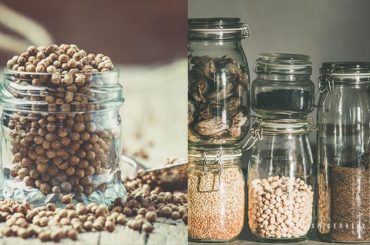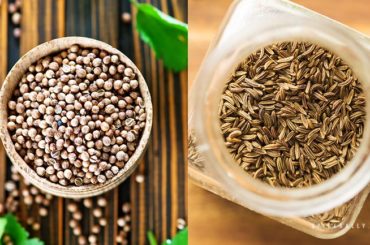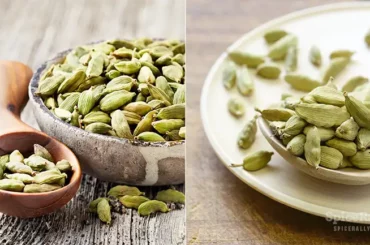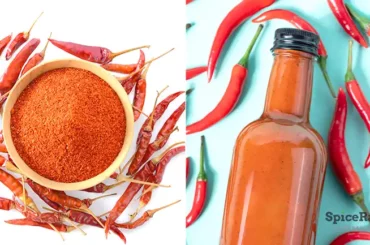Knowing about spices is extremely important when cooking. Especially if you are a newcomer to your cooking journey, some spices may seem a bit confusing to you. Likewise, coriander vs cardamom is a battle that you often encounter, and that is what we are going to help you with.
Coriander and cardamom are two from the great C’s of the culinary world- Cumin, Cardamom, and Coriander. Despite the fact that they both are spices, they differ in their flavor profiles, appearance, plant family, nutrition, and in many other aspects.
Hence, this article will bring you everything you need to know about the difference between coriander cardamom. All you have to do is just to go a few scrolls down!
Coriander Vs Cardamom – Difference Unveiling
Coriander and cardamom are spices that are widely used in many cuisines around the world. And, both of them are kitchen staples, particularly in many Asian countries.

They have unique characteristics that could add a lot of flavor, aroma, and value to the dishes you make. Although they start from the same letter and sound quite similar, they have different effects on the recipes they call for.
The table below will give a clear comparison between these two spices. Refer to the chart and learn what you didn’t know about these two spices before.
Comparison Table Of Coriander Vs Cardamom
| Coriander | Cardamom | |
|---|---|---|
| Flavor profile | Raw seeds are floral, nutty, and warm. Flavor enhances when roasted. | A complex flavor with minty, fresh, piney, fruity notes. |
| Fragrance profile | Warm, nutty, floral, sweet with rose-like undertones. | A fresh, warm, somewhat camphoraceous, eucalyptus and rosemary effect, with hints of lemon and pepper. |
| Forms using and available | As whole seeds and in ground form. | It can be bought as whole pods and in powdered form. |
| Dishes or foods that pair well | Apples Beef Chicken Soup Dry meat rubs Marinades Spice blends Seasonings Biscuits Bread Eggs Ham Lentils Onions Plums Pork Potatoes | Curries Sweet dishes Rice dishes Beverages Baked goods Apples Oranges Pears Legumes Sweet potatoes Other root vegetables Yogurt Chicken Fish Seafood Pork Beef Lamb |
| Culinary Use | – As a spice – A key component in many spice blends and seasonings – As a tea | – As a spice – Works as an aromatizer and flavoring in many rice dishes |
| Availability | Widely available as whole seeds or powder at leading supermarkets, local grocers, or online sellers. | Cardamom is generally among the most expensive spices in the world. But, it can be bought from leading supermarkets, grocery stores, and online sellers as whole pods and in powdered form |
| Other names | Leaves and stalks are called Cilantro. | Ilachi Elettaria Cardamomum (Latin) “Queen of spices” |
| Price | – A 7-ounce whole seed packet will cost around $3.30 – A 14-ounce packet of coriander powder will cost about $2 | – A 3.5-ounce packet of whole cardamom pods will cost around $9 – A 1.8-ounce container of ground cardamom will cost about $5 |
| Shelf Life | If appropriately stored in containers with tight-fitting lids, whole coriander seeds could stay fresh for up to 3-4 years. And, ground coriander, when stored in containers with tight-fitting lids, will stay fresh for up to 2-3 years | If stored in a tightly sealed container, whole cardamom pods will stay fresh for around one year. Even if properly stored, ground cardamom can only stay fresh with the flavor only for a few months. |
| Health benefits | – Acts as a stomach-soothing medicine – Relieves upset stomach and flatulence – Eases pain and swelling from arthritis and rheumatoid arthritis – Reduces acidity, treats diarrhea, and chronic dysentery – Relieves stomach pain caused due to indigestion Improve digestion. – It helps lower and controls blood sugar – May help to minister several skin conditions – Reduces LDL cholesterol levels and boosts cardiovascular health. – It helps to fight against Salmonella. – Useful for eye health. – Supplies protection against neurodegenerative diseases. | – It contains antiseptic and antispasmodic properties – Rich in anti-inflammatory effects Beneficial in dental-related health issues – An antidote to snake venom – Treats gastrointestinal disorders – Lowers blood pressure – It May contain properties that could fight against cancer – May help with stomach ulcers – Relieves nausea and vomiting caused due to digestive problems – Treats fungal infections – Cardamom essential oil is beneficial in Salmonella bacteria. – May improve oxygen use and breathing – Powdered cardamoms Can lower blood sugar levels |
| Nutrition per 100g | – 23 cal – 10.76g of protein – 3.67g of carbohydrates – 0.52 g of fat per | – 311 cal – 10.76g of protein – 68.47g of carbohydrates – 6.7g of fat |
| Main featuring cuisines | Asian, North African, European, Middle Eastern. | Middle Eastern, Indian, Pakistan, European, Japan, US. |
| Appearance | Round, brown, tiny, light-weighted. | Cardamom seeds are inside a pod that has a shape of a spindle. Every pod contains multiple seeds which are tiny and black in color. |
| Harvesting | Coriander fruits are usually set around 120 days from the day the plant is grown. Then when the coriander fruit eventually turns brown, they are ready to harvest. | The fruits should only be harvested once they are completely ripe and mature. A ripe pod has black seeds, while immature pods contain white seeds. When a cardamom pod is grown, it can be easily extracted from the stem of the tree. The pods that do not easily come out of the branch should be left in the tree to ripen. |
| Scientific name | Coriandrum sativum | Elettaria cardamomum |
| Plant Family | Apiaceae | Zingiberaceae |
| Origin | Origin not specified. | The coastal area of India. |
| Coriander | Cardamom |
What Is Coriander?
After referring to the table above, you might be interested in learning something more about coriander. In fact, the coriander we referred to here is the coriander seeds which we often use as a spice.
But the whole coriander plant is edible, including seeds, leaves, stalks, and even roots. In the USA, the seeds of this plant are called coriander seeds and leaves and stalks as cilantro. At the same time, the other countries apart from the USA refer to the seeds as coriander seeds and the rest of the plant coriander.
For further reference, click here for a complete article that includes everything you need to know about coriander.
What Is Cardamom?
Cardamom is a powerfully aromatic and flavorful spice that has marked its place as “The Queen of Spices”, in the world of spices. It is also one of the most expensive food flavorings that accounts for a great labor intensity during the harvesting process.
Cardamoms are available as green cardamoms and black cardamoms. But, Green cardamoms are the most widely available and used type in the USA. The flavors of the two kinds of cardamoms are different from each other. And, black cardamoms are more robustly flavored and possess a smokiness due to their processing.
Be like cardamom; aromatic and flavorsome when gently worked with. But destroys every taste when crushed.
Parag Agarwala
The green variety is typically used in many sweet and savory dishes. But we do not see black cardamoms contribute to sweet dishes or baked goods. And thus, green cardamoms come with much versatility and add so much flavor and aroma to the dishes it calls for.
Can You Use Substitute Cardamoms With Coriander And Vice Versa?
Although both of these spices greatly influence the taste and aroma of the dishes we add, substituting each other is not a good idea due to the distinct flavor profiles. In fact, cardamom possesses a very unique menthol-like flavor that coriander does not have.
However, the expert chefs suggest combining other spices like cumin and ginger would make a good cardamom substitute. And, you can also use coriander with cumin and a few other spices to get the powerful flavor that cardamom provides.
Substituting cardamoms in coriander also could work the same way. If you use cardamoms in the dishes that call for coriander, that could be a bit overpowering. So you will have to go for other coriander seed alternatives like caraway seeds and cumin.
Just take a minute to read our article on the nine best coriander substitutes to know all the possible ingredients you can use instead of coriander seeds and coriander leaves.
Coriander Vs Cardamom – Usage In Cooking
It is no secret that both of these flavorings add so much flavor, aroma and enhance the texture of a particular dish. When talking in terms of cooking, they both can be included in sweet and savory dishes and blend really well with other ingredients.
Coriander pairs well with other spices like cumin, fennel seeds, ginger, allspice, caraway seeds, chili, cinnamon, garlic. In the meantime, cardamom makes good teams with ginger, cumin, cinnamon, mustard, paprika, turmeric, anise, pepper, and allspice.
Moreover, coriander is excellent with dry meat rubs, while cardamom becomes a good addition when making red meat, fish, or seafood curries. And coriander also gets along well with cruciferous vegetables and bread and some types of biscuits. On the other hand, cardamom is great with legumes, grain dishes, rice dishes, tea, and other beverages like mulled wine and iced coffee.
Overview Of The Difference Between Coriander And Cardamom
Cardamom and coriander both are aromatic and powerful spices that make our food really beyond our taste imagination. They come from different plant families, with different shapes, flavors, and scent profiles, and also vary in nutrition. But, one will not obviously overpower the taste of the other.
Unlike coriander, only the pods of the cardamom plant are included in the culinary use. And, cardamom is comparatively more expensive than coriander which is considered one of the most highly-priced spices in the world.
Now since you discovered the differences between coriander and cardamom, you may be interested in learning the facts about coriander and cumin, too. Just click here for a complete guide on coriander vs cumin.




